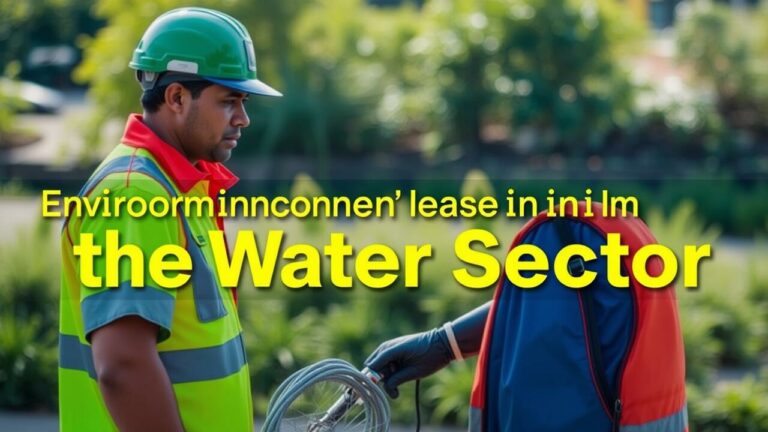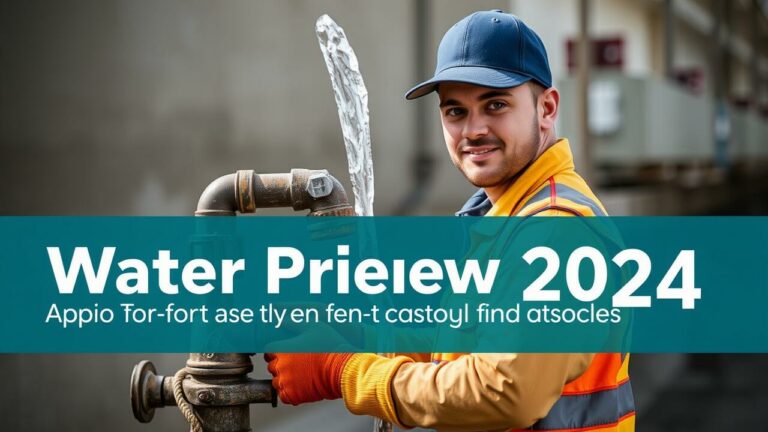Water Industry News Latest Developments and Insights
Water scarcity is morphing into a pressing global dilemma, affecting millions across varied landscapes. The predicament deepens under the weight of swift urban sprawl, climate upheaval, and glaring inefficiencies in how we manage our water resources. A stark imbalance looms large—water supply grappling against soaring demand—fueling escalating tensions over these precious resources. As populations swell and industries burgeon, the strain on freshwater reserves is poised to amplify, demanding immediate action and out-of-the-box solutions.
In numerous corners of the globe, groundwater stocks are vanishing at a pace that far outstrips nature’s ability to replenish them. This relentless extraction not only jeopardizes future access to water but also wreaks havoc on ecosystems reliant upon these critical sources. It’s imperative for policymakers and stakeholders alike to pivot towards sustainable methods for managing existing supplies with finesse. Embracing strategies that champion conservation efforts, revamp distribution systems, and invest in cutting-edge technologies for water reuse will be crucial in tackling this escalating crisis of water scarcity head-on.
Case Studies on Successful Desalination Projects
Desalination has surged forth as a pivotal remedy for the pressing freshwater shortages plaguing diverse regions across the globe. Take, for instance, the Sorek desalination plant in Israel—a behemoth among its counterparts and one of the largest facilities on Earth. Established in 2013, this cutting-edge installation harnesses reverse osmosis technology to churn out an astounding 627,000 cubic meters of water each day! The triumph of this project is nothing short of remarkable; it has played a crucial role in fortifying Israel’s water security strategy, showcasing both the efficacy and promise embedded within contemporary desalination techniques.
Then there’s the Adelaide Desalination Plant down under in Australia—another stellar example that kicked off operations in 2013. This facility stands as a linchpin in combating drought and adapting to unpredictable climate shifts. With a capacity to deliver up to 100 gigaliters of potable water every year, it even incorporates renewable energy into its framework, crafting a sustainable operational blueprint. These vivid instances underscore how judicious investments in desalination not only enhance resilience against looming water scarcity but also diversify supply avenues with ingenuity and foresight!
The Impact of Climate Change on Water Resources
Climate change casts a long shadow over water resources worldwide, shaking the very foundations of how we manage this vital resource. As temperatures soar, evaporation rates skyrocket, twisting precipitation patterns into unpredictable shapes—some areas suffer through relentless droughts while others find themselves inundated with floods. This tug-of-war on our water supply systems sends ripples through agriculture, industry, and everyday life. With freshwater reserves increasingly at risk, communities are left scrambling to adapt and forge sustainable water management practices.
Yet the unpredictability of water availability complicates planning for these precious resources. The old models that leaned heavily on historical data? They’re quickly becoming relics of a bygone era—what was once reliable is now fraught with uncertainty. We need fresh strategies: adaptive frameworks that recognize and respond to ongoing climate shifts become essential lifelines in this tumultuous landscape. Improved forecasting techniques melded with integrated water management strategies rise to prominence as the key tools needed to tackle the chaos brought by climate change’s effects. Collaboration among all stakeholders emerges as an urgent necessity—a collective effort toward building resilient systems capable of weathering new environmental challenges ahead.
Adapting to Fluctuating Water Availability
Water availability dances to the unpredictable rhythms of climate shifts, population movements, and the intricate web of water management practices. In this ever-changing landscape, communities are finding that adaptive strategies aren’t just beneficial—they’re essential lifelines. Picture rainwater harvesting as a clever ally or advanced irrigation techniques swooping in to optimize supply like seasoned professionals on a mission.
As if navigating a labyrinthine puzzle, implementing smart water systems emerges as a beacon of precision. These technologies allow for an astute monitoring and control mechanism—think finely-tuned orchestras deftly utilizing every note of available resources.
In this swirling maelstrom of challenges, communities are awakening to the critical significance of resilience woven into their water infrastructure fabric. By diversifying sources and pouring investments into storage solutions, regions grappling with scarcity can soften the blows dealt by droughts and erratic rainfall patterns. Moreover, when local stakeholders roll up their sleeves to engage in planning and decision-making processes, it’s not merely about strategy; it’s about crafting responses tailored intricately to each community’s unique tapestry.
This collaborative endeavor cultivates a vibrant culture of sustainability—a dynamic ecosystem where adaptive capacities flourish amidst the relentless ebb and flow of environmental change.
Public-Private Partnerships in the Water Industry
Public-private partnerships (PPPs) have burst onto the scene as a crucial tactic for tackling the mounting challenges in the water sector. These dynamic collaborations harness the strengths and resources of both public agencies and private firms, leading to enhanced project efficiency and a surge in investments aimed at bolstering water infrastructure. Through a shared approach to risk-taking and responsibility, stakeholders can ignite innovation, elevate service delivery, and ultimately forge sustainable solutions for managing our precious water resources.
But wait—there’s more! The perks of jumping into PPPs extend beyond mere financial gain. These alliances open doors to cutting-edge technologies and best practices that propel improvements in both water quality and accessibility. They also encourage active stakeholder engagement, placing community needs front and center. In an era where water scarcity looms large alongside aging infrastructure threatening stability, these collaborative strategies offer a powerful pathway toward building resilient water systems capable of adapting to ever-shifting demands.
Benefits of Collaborative Approaches to Water Projects
In the intricate tapestry of the water industry, collaborative approaches emerge as a beacon of enhanced resource allocation and efficiency. Imagine this: stakeholders—each wielding their unique expertise and financial clout—coming together to confront the labyrinthine challenges of water management with newfound vigor. It’s not just about sharing burdens; it’s about weaving shared infrastructure investments that ease individual financial strains while amplifying the effectiveness of every dollar spent.
But wait, there’s more! These alliances breathe life into stakeholder engagement and ignite community involvement in ways previously unimagined. Picture local governments partnering with private enterprises and non-profit organizations, crafting platforms for collective problem-solving that shimmer with transparency and foster public trust. Involving local communities isn’t merely a checkbox; it ensures projects resonate deeply with specific needs and values, paving the way for superior outcomes that bolster the sustainability of water initiatives like never before.
| Collaborative Approach | Key Stakeholders | Benefits | Example Project |
|---|---|---|---|
| Public-Private Partnerships | Local Governments, Private Firms | Shared Financial Risks, Improved Infrastructure | Desalination Plant Development |
| Community Engagement | Non-Profit Organizations, Local Communities | Increased Trust, Tailored Solutions | Water Conservation Awareness Campaign |
| Integrated Water Resource Management | Government Agencies, Environmental Groups | Holistic Solutions, Sustainable Resource Use | Watershed Management Initiative |
| Cross-Sector Collaborations | Academic Institutions, Industry Experts | Innovative Approaches, Knowledge Sharing | Urban Water Resilience Research |
Innovations in Water Monitoring and Data Analytics
The convergence of cutting-edge technologies is reshaping the very fabric of water monitoring and data analytics in ways that are both astonishing and multifaceted. An intricate web of advanced sensor networks now captures real-time information, empowering operators to track water quality and usage with a level of precision previously deemed unattainable. Meanwhile, machine learning algorithms delve into vast oceans of data, sifting through trends and anomalies that could signal lurking threats—be it contamination or inefficiencies in distribution systems. These revelations furnish municipalities and water management agencies with the tools needed to make judicious choices, thereby boosting operational efficiency while adhering to regulatory mandates.
Enter the realm of IoT devices—a game changer on a global scale for how we perceive and manage our precious water resources! Smart meters unveil intricate patterns in consumption, granting consumers and utilities alike the ability to fine-tune their usage strategies. Predictive analytics emerge as stalwart allies in this quest for resource stewardship, enabling swift action against looming crises like droughts or system breakdowns. As these technological marvels continue to advance at breakneck speed, they not only pledge improvements in oversight regarding water quality but also herald an era where sustainable management practices become second nature when it comes to safeguarding this essential resource.
Utilizing IoT for Real-Time Water Quality Monitoring
The melding of Internet of Things (IoT) technology with water quality monitoring is nothing short of revolutionary, ushering in a new era where real-time data collection and analysis take center stage. Imagine sensors scattered across countless water bodies, tirelessly measuring an array of parameters—pH levels dancing on the edge, turbidity swirling unpredictably, dissolved oxygen fluctuating like a heartbeat, and contaminants lurking ominously. This constant stream of data isn’t just information; it’s empowerment for water management authorities who can leap into action at the first sign of irregularity or pollution crisis. Public health hangs in the balance as these guardians work to shield both people and planet from harm.
But wait! There’s more! The deployment of IoT devices spins a web—a vast network rich with comprehensive data that supercharges predictive analytics. When organizations weave together insights from diverse sources, they unveil trends and potential pitfalls before they spiral out of control. This forward-thinking strategy transforms how we manage our precious water resources, fostering efficient allocation while igniting collaboration among local governments, private enterprises, and environmental advocates alike. With enhanced visibility into these critical metrics comes the power to drive policy shifts and fuel investments in vital water infrastructure—not just reacting but readying ourselves against contamination crises and shortages that threaten our very existence!
Future Directions for Water Industry Research
In the ever-evolving realm of the water industry, research is diving headfirst into a quest for sustainable solutions that tackle urgent environmental dilemmas. The spotlight shines on innovative technologies aimed at ramping up water efficiency and refining treatment processes—these are not just goals; they are imperatives! Picture this: renewable energy sources weaving their way into water treatment facilities, promising to slash carbon footprints in ways we’ve only begun to imagine.
But wait, there’s more! Delving into advanced filtration systems and chemical treatments could revolutionize purification methods, ensuring safe drinking water flows freely across diverse landscapes. It’s like unlocking a treasure trove of possibilities!
Yet, here’s where it gets even more intriguing: collaboration is the name of the game. A symphony composed of academic institutions, government entities, and private enterprises must harmonize to propel future breakthroughs. Think cross-disciplinary approaches that meld insights from data science with urban planning—a recipe for groundbreaking perspectives on resource management!
And let’s not overlook climate-resilient infrastructure paired with adaptive strategies; together, they’ll be crucial in helping communities navigate the turbulent waters of scarcity. This relentless commitment to research isn’t merely about technological advancements—it’s about crafting pathways toward broader access to clean water. In turn, this will enhance global health and fortify sustainability efforts around the globe! What an exhilarating journey lies ahead!
Focus Areas for Next-Generation Water Solutions
In the swirling landscape of tomorrow, emerging technologies stand as beacons for safeguarding our water supply and its quality in the decades ahead. Picture this: cutting-edge purification techniques are on the rise, showcasing advanced filtration systems that wield nanotechnology and other groundbreaking materials like a magician’s wand. These innovations promise not just heightened efficiency but also slashed costs—an alchemy that could transform communities grappling with acute water scarcity into bastions of sustainability.
But wait! There’s more to this unfolding narrative. Enter artificial intelligence, weaving itself into the fabric of water management—a game-changer indeed! With its uncanny ability to forecast demands with razor-sharp precision and allocate resources efficiently, AI ensures that our precious water supplies can dance gracefully in sync with real-time needs.
Yet amid these advancements lies another crucial chapter: fortifying our water infrastructure against the unpredictable whims of climate change. As extreme weather events surge forth like tempestuous waves crashing upon shores, it becomes paramount to weave adaptive strategies into both design and operation. We must cultivate resilient networks that can brave floods and droughts alike while embracing nature-based solutions—think wetlands restoration as a restorative balm for Mother Earth.
It is here, at this intersection of innovation and environmental stewardship, where investing in research focused on sustainable practices shines brightest. Adaptive management will serve as an essential compass navigating us through the turbulent waters posed by shifting climates and burgeoning populations—a journey we cannot afford to overlook.
- Invest in advanced purification technologies utilizing nanotechnology and innovative materials.
- Implement artificial intelligence for predictive water demand management and resource allocation.
- Develop infrastructure that can adapt to extreme weather events, enhancing resilience against climate change.
- Embrace nature-based solutions like wetlands restoration to improve water management and ecosystem health.
- Foster collaboration between public and private sectors to drive investment in sustainable water practices.
- Prioritize research and development focused on adaptive management techniques tailored to local needs.
- Educate communities on the importance of water conservation and sustainable usage practices.
Conclusion
As the swirling tempest of water scarcity, climate upheaval, and rapid technological evolution unfolds, the water industry finds itself at a pivotal crossroads—one that demands nimble adaptation to safeguard this indispensable resource. Stakeholders—ranging from government entities to corporate giants and grassroots communities—must unite in a symphony of innovation, embracing cutting-edge technologies and forging alliances that meld public insight with private prowess. Such collaborations can act as catalysts for optimizing our approach to water resource management while fortifying resilience against unpredictable shocks.
Enter the realm of advanced monitoring solutions and data analytics—the beating heart of tomorrow’s water systems. By casting a spotlight on research into groundbreaking technologies, the industry stands poised not just to confront current hurdles but also to anticipate future needs with agility. Nurturing a forward-thinking ethos will empower the global community to protect precious water resources more effectively, ultimately yielding brighter outcomes for both humanity and our planet’s delicate ecosystems.







